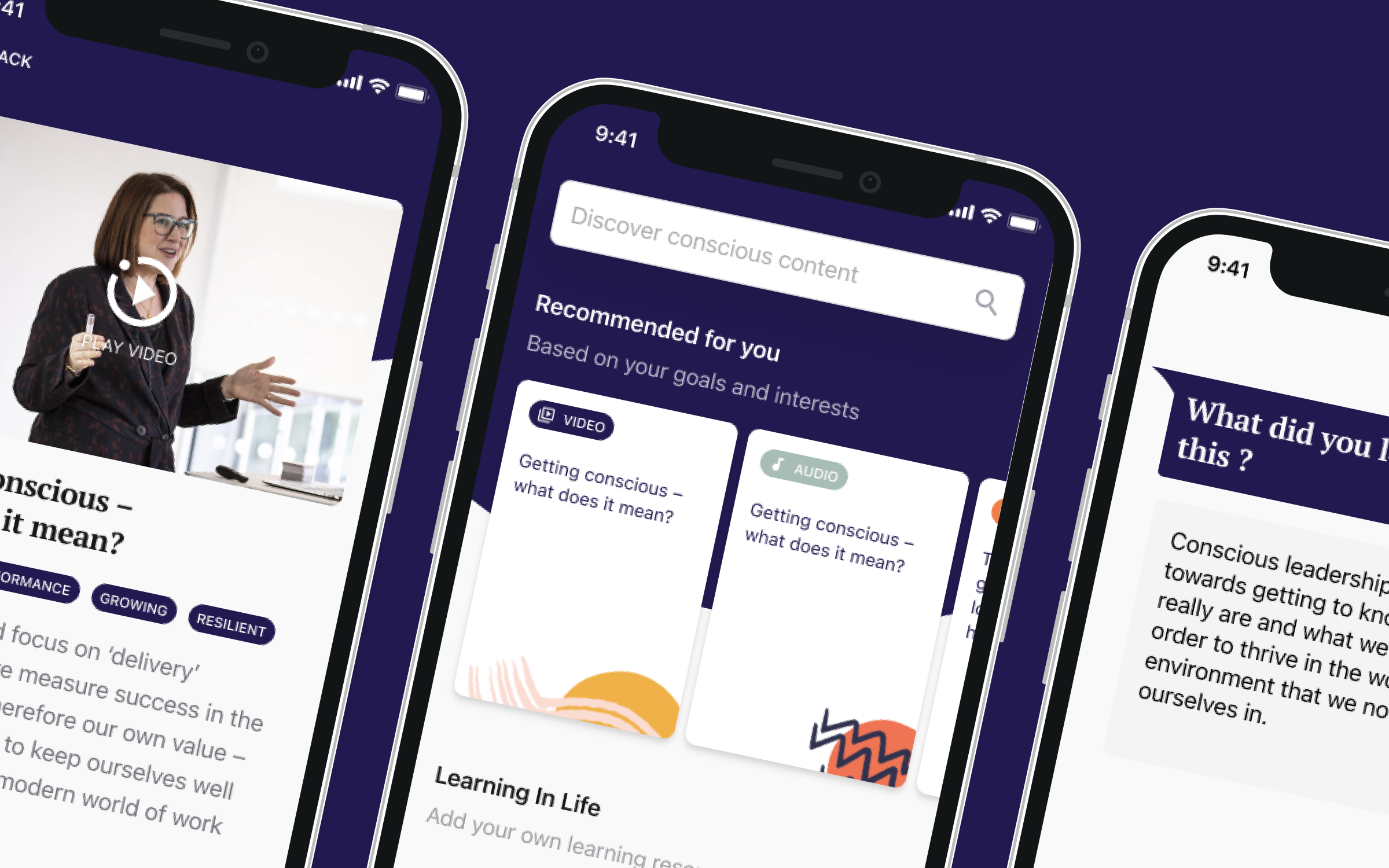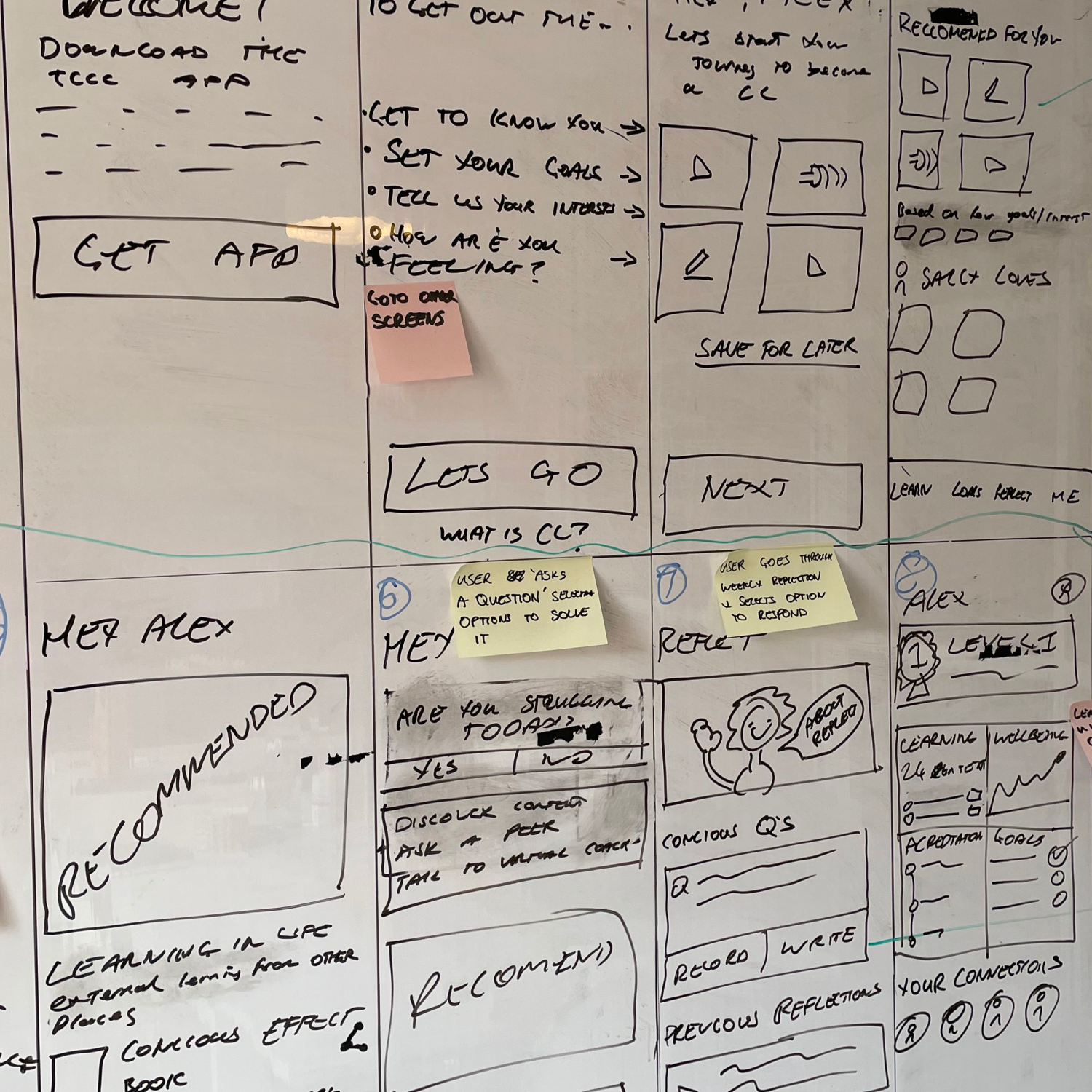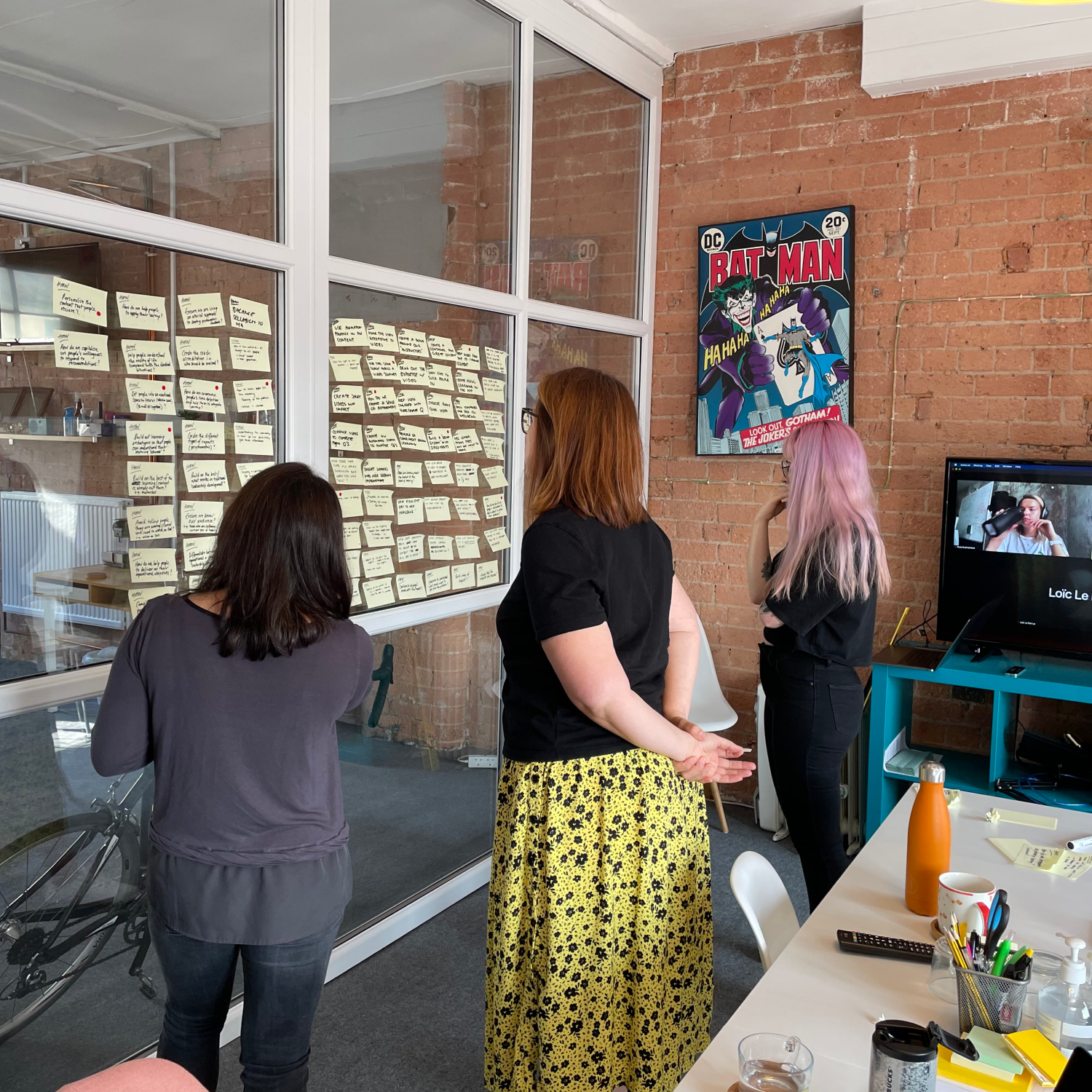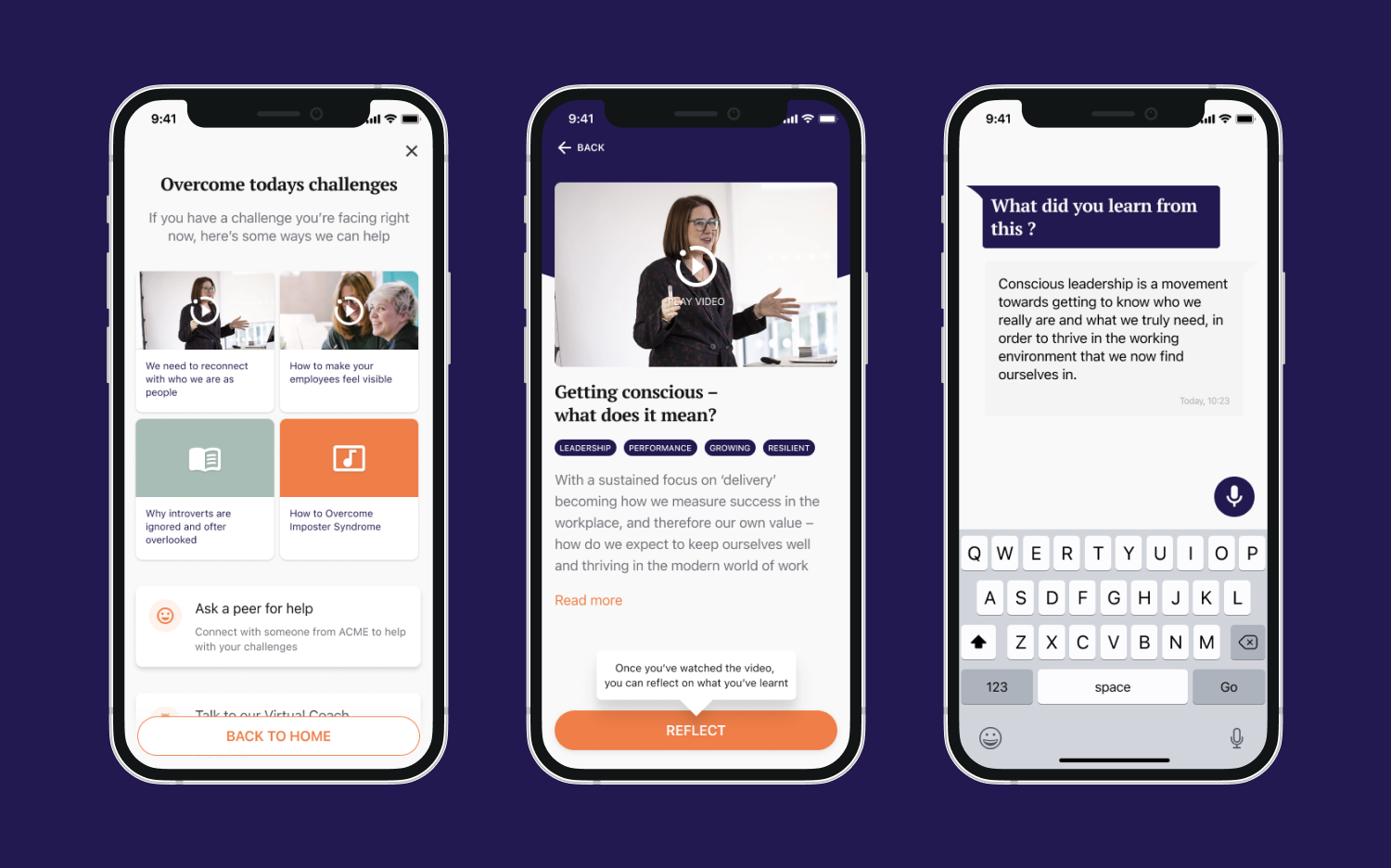

Prototyping a 'coach in your pocket' for a B2B learning development startup
We helped TCLC and their founder Natasha Wallace to understand how we can empower leaders to be more conscious and improve their wellbeing using a 5 Day Design Sprint.

Talking to leaders
We kicked of the session by understanding what we already knew about leaders and what we wanted to find out. Mita, TCLC's CPO, already had lots of data around the current market for leadership development. But we still needed to find out what leaders themselves thought. How did they approach development? How conscious were they already?
So we sat down 1:1 with several key leaders to learn about the challenges they faced whilst managing and supporting their team. We were particularly interested in understanding what they wanted to develop and improve, and if they had access to existing development tools
We found that many leaders we spoke to are actively interesting in developing and learning. They currently learn from a variety of sources. Despite that, there were a few consistent places leaders went to develop and learn. One of those was their peers. All the leaders we spoke to learnt from their peers. Another was books, podcasts, and videos. Self-learning was something that was consistent for leaders in companies that supplied rich development programs and those where development programs were nonexistant.
Challenges varied between leaders and companies. However, time was a huge barrier to development. Having the time to focus on development was, the leaders felt, the biggest thing holding them back from growing as a leader.


Gathering the experts
To bring together not only our own research, but data and expertise from other sources, we started to run the Design Sprint. The first exercise of the day was to share all the pockets of knowledge both within the team and outside it. We listened to Natasha give her vision and the core mission of Conscious Leadership. We also spoke to Popcorn, a UK based learning media agency, on their experience creating visual media for learning platforms. We brought experts from UCL and Oxford to talk about the psychology of learning and presented our own research from speaking to both leaders and HR buyers.
The team collated all this knowledge into HMW notes. This allowed everyone to document what we'd heard and standardise all the learnings into challenges we could take into the design process. Afterwards, we mapped out the ideal journey for all our user personas and combined our prioritised challenges to give ourselves a good understanding of where our focus should be for the Design Sprint.
Conscious prototyping
Our design team created a prototype of the learning platform for leaders. From our research and early workshops, we found that this is where we had our biggest challenges and assumptions. We wanted to understand how our leaders would understand the product, what types of learning content would they engage with, and how our product can compliment their existing learning approach.
The team created a mobile prototype in a single day, focusing on the key areas; onboarding users, engaging with content, reflecting on what they've learnt, and looking at their learning profile. From our initial research, we know that a social element to learning was a big feature of our leaders approach to learning. We dotted different social options around the app, observing carefully how users reacted to them and understanding how what, if any, value this would provide.

Testing with real users
On Thursday of the Design Sprint week, we sat down with 5 leaders to test out our prototype. We setup a Zoom call and asked them a few questions around their roles as leaders. We then shared our prototype with them, asking them to complete a few tasks so we could observe how they use the product. We collated our feedback, mapping them to each of the key questions we wanted to answer.
One of the biggest standouts from our testing is the variety of content we included (video, podcasts, and articles) was very attractive to users. The quality of the content was key and having a good library of content was a definite value add to help users learn effectively.
Another key feature that excited users was 'Reflections'. These were journal-style entries where a user would talk about what they've learnt. We set these up periodically (e.g. every week) and after events (e.g. after watching a video). Most users felt this concept was a little new and alien to them, but once the concept was understood we saw a definite 'a-ha' moment. Empowering users to not only learn through content but reflect back on how they've learnt was something put forward to us by Dr David Wilkinson, a learning expert we spoke to earlier in our Design Sprint. This resonated massively with users, which showed us it was a feature worth investing in.
I love the idea of the accreditation [progress tracking]. It really appeals to my competitive nature! – User Testing Participant
Finally, we added a progress element to the product. Giving users tasks and levels to complete was something that appealed to our users. Most users said It would help them build a good habit around developing their learning.
Despite all these positive validations, we did find that our initial approach to onboarding was lacking. We assumed that a short paragraph of text included in a welcome email in the app could prime users for the product they were about to use. Lots of users we spoke to felt that they didn't really understand what the product did until they got into the depths of it. This told us that we need to do more to prime users before they embark on their conscious leadership journey.
Next Steps
All this data has given us a good understanding of how the product should be shaped. Also, we know understand what features provide the most value to users. The goal for the team now is to continue to learn by testing further ideas with users and start to build the MVP to ship early next year.
Like this? You'll love some of our other projects too
Prototyping a 'coach in your pocket' for a B2B learning development startup
We helped TCLC and their founder Natasha Wallace to understand how we can empower leaders to be more conscious and improve their wellbeing using a 5 Day Design Sprint.
Talking to leaders
We kicked of the session by understanding what we already knew about leaders and what we wanted to find out. Mita, TCLC's CPO, already had lots of data around the current market for leadership development. But we still needed to find out what leaders themselves thought. How did they approach development? How conscious were they already?
So we sat down 1:1 with several key leaders to learn about the challenges they faced whilst managing and supporting their team. We were particularly interested in understanding what they wanted to develop and improve, and if they had access to existing development tools
We found that many leaders we spoke to are actively interesting in developing and learning. They currently learn from a variety of sources. Despite that, there were a few consistent places leaders went to develop and learn. One of those was their peers. All the leaders we spoke to learnt from their peers. Another was books, podcasts, and videos. Self-learning was something that was consistent for leaders in companies that supplied rich development programs and those where development programs were nonexistant.
Challenges varied between leaders and companies. However, time was a huge barrier to development. Having the time to focus on development was, the leaders felt, the biggest thing holding them back from growing as a leader.



Gathering the experts
To bring together not only our own research, but data and expertise from other sources, we started to run the Design Sprint. The first exercise of the day was to share all the pockets of knowledge both within the team and outside it. We listened to Natasha give her vision and the core mission of Conscious Leadership. We also spoke to Popcorn, a UK based learning media agency, on their experience creating visual media for learning platforms. We brought experts from UCL and Oxford to talk about the psychology of learning and presented our own research from speaking to both leaders and HR buyers.
The team collated all this knowledge into HMW notes. This allowed everyone to document what we'd heard and standardise all the learnings into challenges we could take into the design process. Afterwards, we mapped out the ideal journey for all our user personas and combined our prioritised challenges to give ourselves a good understanding of where our focus should be for the Design Sprint.
Conscious prototyping
Our design team created a prototype of the learning platform for leaders. From our research and early workshops, we found that this is where we had our biggest challenges and assumptions. We wanted to understand how our leaders would understand the product, what types of learning content would they engage with, and how our product can compliment their existing learning approach.
The team created a mobile prototype in a single day, focusing on the key areas; onboarding users, engaging with content, reflecting on what they've learnt, and looking at their learning profile. From our initial research, we know that a social element to learning was a big feature of our leaders approach to learning. We dotted different social options around the app, observing carefully how users reacted to them and understanding how what, if any, value this would provide.


Testing with real users
On Thursday of the Design Sprint week, we sat down with 5 leaders to test out our prototype. We setup a Zoom call and asked them a few questions around their roles as leaders. We then shared our prototype with them, asking them to complete a few tasks so we could observe how they use the product. We collated our feedback, mapping them to each of the key questions we wanted to answer.
One of the biggest standouts from our testing is the variety of content we included (video, podcasts, and articles) was very attractive to users. The quality of the content was key and having a good library of content was a definite value add to help users learn effectively.
Another key feature that excited users was 'Reflections'. These were journal-style entries where a user would talk about what they've learnt. We set these up periodically (e.g. every week) and after events (e.g. after watching a video). Most users felt this concept was a little new and alien to them, but once the concept was understood we saw a definite 'a-ha' moment. Empowering users to not only learn through content but reflect back on how they've learnt was something put forward to us by Dr David Wilkinson, a learning expert we spoke to earlier in our Design Sprint. This resonated massively with users, which showed us it was a feature worth investing in.
I love the idea of the accreditation [progress tracking]. It really appeals to my competitive nature! – User Testing Participant
Finally, we added a progress element to the product. Giving users tasks and levels to complete was something that appealed to our users. Most users said It would help them build a good habit around developing their learning.
Despite all these positive validations, we did find that our initial approach to onboarding was lacking. We assumed that a short paragraph of text included in a welcome email in the app could prime users for the product they were about to use. Lots of users we spoke to felt that they didn't really understand what the product did until they got into the depths of it. This told us that we need to do more to prime users before they embark on their conscious leadership journey.
Next Steps
All this data has given us a good understanding of how the product should be shaped. Also, we know understand what features provide the most value to users. The goal for the team now is to continue to learn by testing further ideas with users and start to build the MVP to ship early next year.






